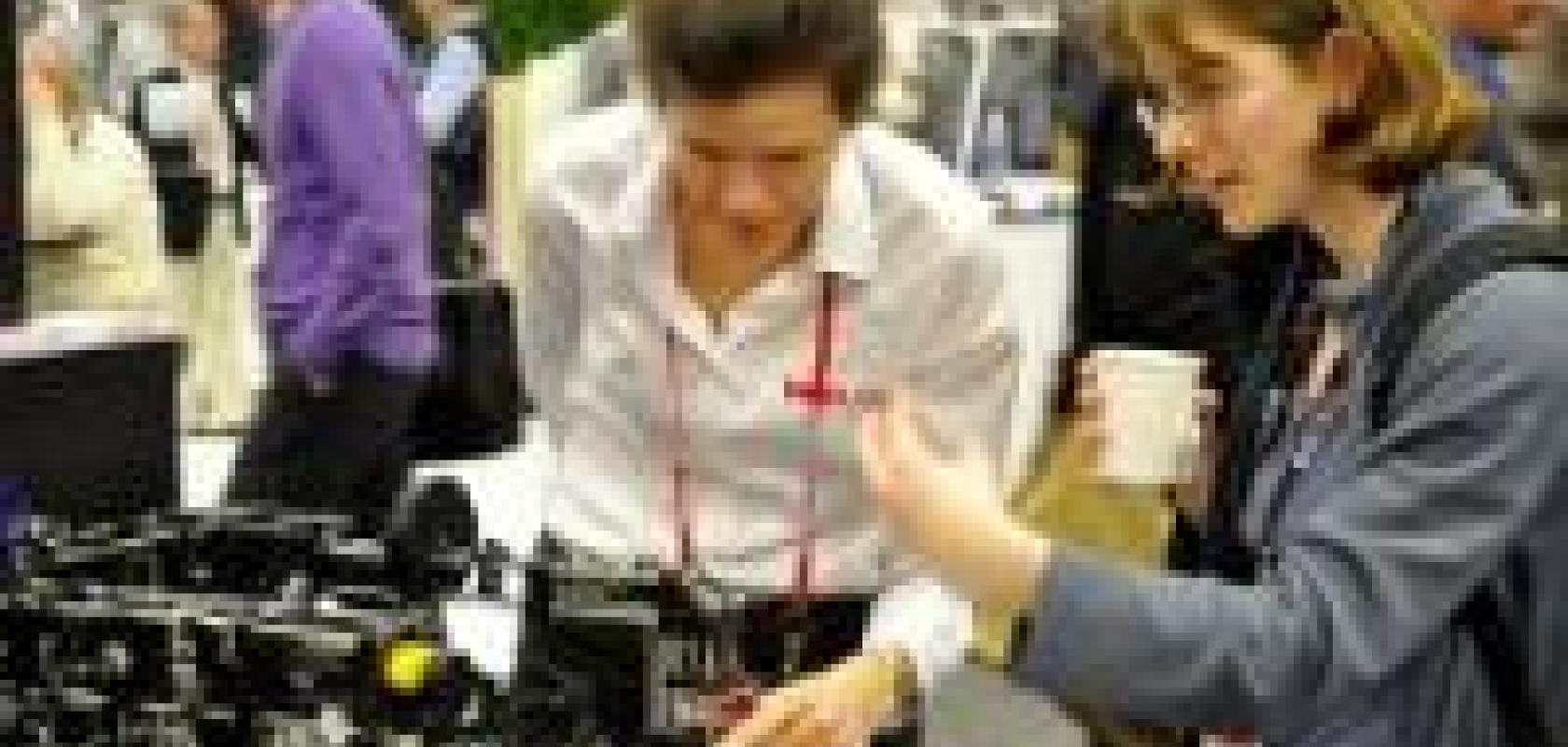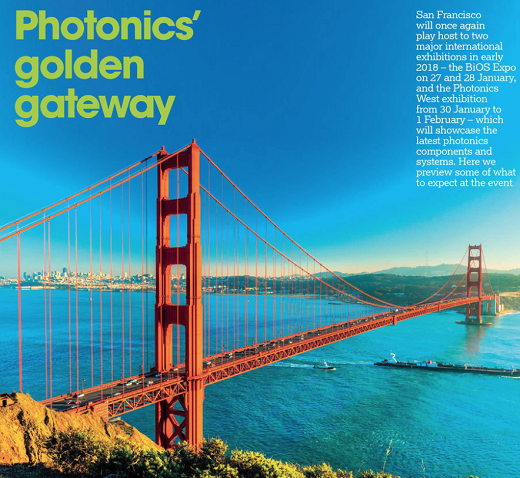SPIE Photonics West

San Francisco will once again play host to two major international exhibitions in early 2018 – the BiOS Expo on 27 and 28 January, and the Photonics West exhibition from 30 January to 1 February – which will showcase the latest photonics components and systems. Here we preview some of what to expect at the event

Conference details
Talks by two Nobel Laureates will be among more than 5,200 technical presentations held alongside the Photonics West exhibition in San Francisco. The symposium is expected to attract an international audience of more than 20,000.
Conferences are organised into tracks on biomedical optics (BiOS), industrial laser sources and applications (LASE), and optoelectronics and photonic materials and devices (OPTO).
Stefan Hell (Max-Planck-Institut Göttingen) and William Moerner (Stanford University), who shared the 2014 Nobel Prize in Chemistry with Eric Betzig (Janelia Research Campus) for their work in ultrahigh-resolution fluorescence microscopy, will give details on the latest advances in the field.
A comprehensive training programme is set to offer more than 70 courses in lasers and applications, sensors, imaging, IR systems, and optical and optomechanical engineering, plus professional development seminars and industry workshops.
Receptions and other networking events will provide many opportunities to share ideas, connect around community issues such as diversity and inclusion, or to meet new potential collaborators.
Highlights
New among this year's 44 BiOS conferences – comprising 2,400 presentations – is the theme, ‘Photonic Diagnosis and Treatment of Infections and Inflammatory Diseases’.
Nine talks in the popular BiOS Hot Topics session will cover topics such as biophotonics for low-resource settings (Katarina Svanberg, Lund University and Sune Svanberg, South China Normal University) and near-future developments in photodynamic therapy (Tayyaba Hasan, Wellman Centre for Photomedicine).
A multi-speaker Neurotechnologies plenary session will include topics such as strategies for observing and controlling neural circuits (Ed Boyden, MIT) and in-vivo imaging of the brain (Na Ji, University of California, Berkeley). Track chairs are David Boas (Martinos Centre, Massachusetts General Hospital, Harvard Medical School) and Raphael Yuste (Columbia University).
A Nano/Biophotonics plenary talk on shaped light will be presented by Kishan Dholakia (University of St Andrews, Scotland).
The Translational Research forum will present outcomes-based studies on technologies, tools, and techniques with high potential to change the lives of patients. Organisers are Bruce Tromberg(Beckman Laser Institute and Medical Centre, University of California, Irvine) and Gabriela Apiou(Wellman Centre for Photomedicine, Massachusetts General Hospital, Harvard Medical School).
BiOS symposium chairs are James Fujimoto (MIT) and Rox Anderson (Wellman Centre for Photomedicine, Massachusetts General Hospital, Harvard Medical School).
Among the 900 presentations in the LASE conference will be plenary talks on laser frequency combs and dual-comb spectroscopy (Ursula Keller, ETH Zurich), optical lattice clocks (Hidetoshi Katori, University of Tokyo and Riken), and industrial laser systems and applications (Berthold Schmidt, Trumpf Photonics).
LASE symposium chairs are Koji Sugioka (Riken) and Reinhart Poprawe (Fraunhofer Institute for Laser Technology).
Highlighting 2,000 presentations in OPTO, plenary talks will cover silicon photonics (Andrew Rickman, Rockley Photonics), nanowire LEDs and diode lasers (Pallab Bhattacharya, University of Michigan), and photonics beyond the diffraction limit (Min Gu, RMIT University). There are three new conferences, on 2D Photonic Materials and Devices, Optical Data Science, and UltraHigh-Definition Imaging Systems.
OPTO symposium chairs are Connie Chang-Hasnain (University of California, Berkeley) and Graham Reed (Optoelectronics Research Centre, University of Southampton).
Industry focus
Market trends and business opportunities will be explored during a variety industry-focused sessions, including: a conference on virtual, augmented, and mixed reality technology challenges and successes, featuring Bernard Kress (Microsoft/Hololens) and Leo Baldwin (Amazon Functional Photonics); panel discussions on silicon photonics and photonic integrated circuits, 3D printing, and other hot technology topics; updated SPIE analysis on the size of the core photonics market; tips on navigating the innovation ecosystem; the annual SPIE Startup Challenge pitch competition for pre-revenue companies; a Fast Pitch Lunch connecting entrepreneurs with potential investors and mentors; and a gala awards banquet where industry leaders will announce winners of the 2018 Prism Awards for Photonics Innovation (see finalists in other panel in this article).
Recruiters from more than 30 companies are expected at the SPIE Career Centre Job Fair (30-31 January).
Prism Award finalists
Disruptive technology for assessing chemical composition in real time, a lidar system for self-driving vehicles, and a smartphone-add-on sensor for noncontact blood pressure and other healthcare tests are among the impressive finalists for the 2018 Prism Awards for Photonics Innovation competition.
The annual event, which is celebrating its 10th year in 2018, recognises innovative product inventions within the optics and photonics field.
Winners will be announced on 31 January at a gala banquet during Photonics West, boosting visibility, recognition, and brand equity for companies bringing innovative products to the market.
‘Ten years in, the Prism Awards are casting an even wider light on the photonics industry. Each year, categories for the awards are driven by the innovations entered, providing direct insight into thriving and emerging “hot” markets,’ said SPIE CEO Eugene Arthurs. ‘New this year are categories for inventions in Environmental Monitoring and for Illumination and Light Sources – very timely as the world continues to work toward more sustainable energy sources and devices.’
The finalists are as follows:
Detectors and Sensors
- NKT Photonics: LIOS EN.SURE Long Range DTS and RTTR
- Princeton Infrared Technologies: LineCam12
- Xenics: XLIN FC 2048 detector
Environmental Monitoring
- Block Engineering: LaserWarn analyser
- Blue Industry and Science: X-FLR8 V2
- Daylight Solutions: ChemDetect mid-IR liquid analyser
Illumination and Light Sources
- Lumileds: Luxeon 3535L HE Plus line LEDs
- Osram Opto Semiconductors: SFH 4735 high-power infrared emitter
- SoraaLaser: LaserLight fibre module
Imaging and Cameras
- Daylight Solutions: Spero-QT infrared microscope
- Luminar: Model-G 3D Lidar
- Teledyne Dalsa: Piranha4 polarisation line scan camera
Lasers
- Class 5 Photonics: Supernova OPCPA
- KMLabs: Y-Fi OPA
- Optores: NG-FDML (wavelength-swept laser)
Life Science Instrumentation
- neaspec: cryo-neaSNOM
- Quantumcyte: Q1
- Tomocube: HT-2 (Holotomographic microscopy with 3D fluorescence imaging)
Material Processing and Additive Manufacturing
- Han's Laser Technology Industry Group: (UV laser system for PVD ablation processing)
- Limo: Activation Line UV-L750
- Nuburu: AO-150 (high-speed infrared 150W laser)
Medical Diagnostics and Therapeutics
- ContinUse Biometrics: SmartHealth Mod (smartphone biosensor)
- Lightpoint Medical: LightPath Imaging System (intra-operative luminescence imaging)
- Lumedica: OQ LabScope (low-cost OCT)
Optics and Optomechanical Components
- AdlOptica Optical Systems: foXXus (multi-focus optics)
- Optotune Switzerland: MR-15-30 (dual axis vector scan mirror with position feedback)
- Spectrolight: Flexible Wavelength Selector
Test and Measurement
- Gamma Scientific: GS-1290-NED (near eye display measurement system)
- Si-Ware Systems: NeoSpectra Micro (chip-sized spectral sensor)
- Spheryx: xSight (holographic suspension analysis device)
